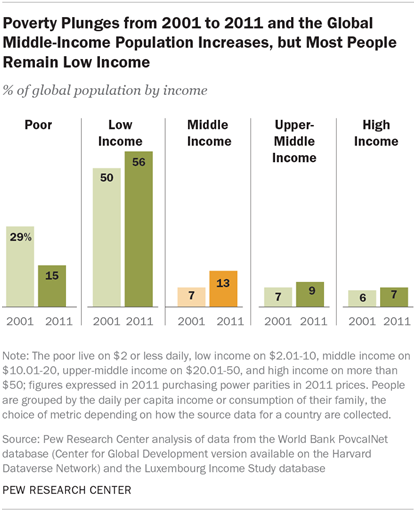
It may seem contradictory when the middle classes in emerging economies (now going through a slowdown) are growing like never before. But according to some studies, their numbers have been exaggerated. And in a good deal of Europe and the US, the middle classes are in free-fall, something that may have effects on the stability of the political system, with, in some cases, the rise of radicalism (whether on the extreme right or the extreme left) and of various brands of populism (like that of Le Pen in France and Trump in the US). Or, in the opposite direction, the decline of left-wing populism in parts of Latin America.
In the US, the world’s largest economy (although some statistics are already suggesting it has been surpassed by China), for the first time in 40 years the people customarily understood as middle class now only account for half the population, according to research from the Pew Center. The share of Americans in upper-income households has grown, and so has that of people in lower-income households. Those in the middle now number 120.8 million, while upper- and lower-income Americans combined number 121.3 million. The Pew analysis concludes that we may have reached a tipping point in American society.
The average salary of an assembly-line worker in the US has not only not risen in 40 years, but in real terms (allowing for inflation) has fallen by 13%; meanwhile, as Martin Ford points out, referring to data from 2013, productivity has gone up by 107%. The situation has deteriorated with the economic crisis: many young people entering the labour market are unable to find work or, if they can, it is low-paid work.
There are various reasons for this, including the disproportionate increase of capital compared to manpower, technological advances and competition with other countries affected by globalisation. Robert Reich, in his recent book titled Saving Capitalism: For the Many, Not the Few, adds the decline of trade unions, job insecurity and in general a deterioration of the negotiating capacity of the middle classes. They have lost bargaining power, not only in the US but throughout the Western world. Moreover, according to research conducted by Shawn Sprague (Bureau of Labor Statistics), the American economy managed to increase its output by 42% between 1998 and 2013, although the number of hours worked stood still, something that explains a great deal.
In global terms it might be thought that the decline of the middle classes in developed economies is offset by the fact that they are flourishing in the emerging world, as indicated last year in a study carried out by BBVA, according to which these classes may account for two thirds of the world’s population by 2025, doubling in other words the share they had in 2000, which would reduce inequality at a worldwide level (though this is not the same as in each individual society). The study foresees emerging countries accounting for 67% of the middle and affluent classes at a worldwide level in 2025 as opposed to 24% in 2000, with huge consequences for levels and types of consumption. Asia, and above all China, followed by Latin America and Eastern Europe lead the trend for generating members of the middle classes.
Be that as it may, another study by the Pew Research Center, published last summer, while accepting the growth of the world’s middle classes (which have doubled in size in a decade), contains figures indicating that they are smaller and poorer than is commonly believed, with hundreds of millions of people in such groups at risk of having their income levels reduced. China and other Asian economies are the countries that are distorting the global figures. Only 16% of the world’s population lives on incomes higher than what in the US and Europe would be considered the poverty line. Some earlier estimates claimed that the world’s middle classes were made up of some 2 billion people. The Pew estimate (with a broad definition of the middle class as people on incomes of between US$10 and US$100 per day) reduces this to 1.7 billion, which would represent significant progress in recent times but less than had been thought. (Incidentally, if readers are interested in finding out which income group they belong to they can do so using the calculator devised by the Pew Center).
In his interesting study, Branko Milanovic points out that the poorest emerge as the losers in this situation, but also those that fall between the 75th and 90th percentiles for wealth, in other words the most numerous section of the population, the middle classes. Here it should be noted once again that China and India, the countries with the greatest populations and the highest growth, distort the statistics.
Notwithstanding the above, the figures for absolute poverty have declined, which is excellent news. The World Bank estimates that in 2015 the number of people in absolute poverty (those who live with less than US$1.9 per day) fell below 10% for the first time, although the target of eradicating it by 2030 (one of the Sustainable Development Objectives endorsed by the UN) will be difficult to attain. Milanovic arrives at a clear conclusion: ‘either poor countries will become richer, or poor people will move to rich countries’. And this is a phenomenon we are indeed seeing.
The Pew research suggests that 71% of the world’s population was still poor or low-income in 2011, although in the preceding decade 670 million people emerged from absolute poverty. From the international perspective the gap –the difference in living standards between the advanced economies and the emerging and developing economies– narrowed only slightly in the first decade of this century. In 2001, 91% of people with high incomes lived in North America and Europe, and in 2011 it was still 87%.
The middle classes matter a great deal. The economist Tyler Cowen’s book has been translated into Spanish under the title Se acabó la clase media (‘The Middle Class is Finished’), although the original title is more accurate: Average is Over. In other words, the average now tells us little and the middle ground has been depopulated. All this comes laden, as mentioned above, with potential political and international consequences.



